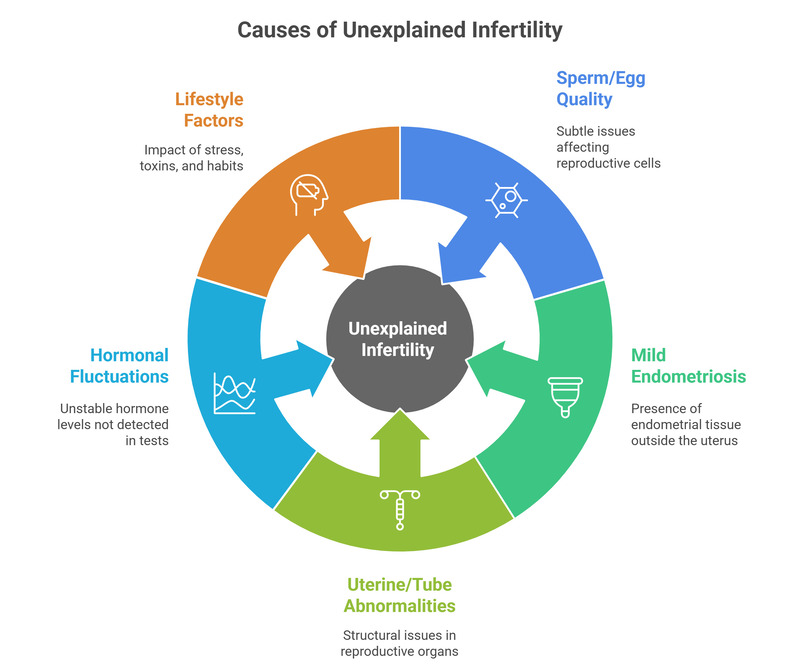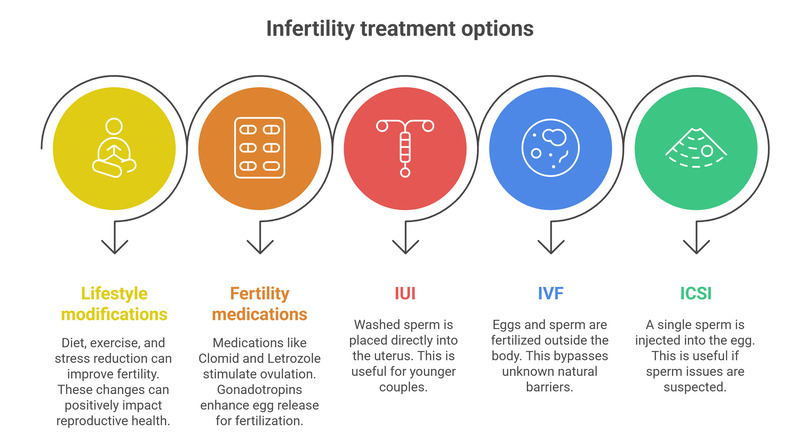In India, an educated couple from Bangalore, married for five years, went through every possible fertility test – semen analysis, ovulation tracking, hormone profiling, ultrasound scans – and everything came back “normal.” Yet, after more than two years of trying naturally, they couldn’t conceive. Doctors finally diagnosed them with unexplained infertility.
This is the reality many couples face. Unexplained infertility means that after thorough medical evaluation, no clear medical cause is found for why pregnancy is not happening. It’s often referred to as a diagnosis of exclusion – all common causes are ruled out, but the couple still struggles with conception.
So, what does unexplained infertility really mean, and what solutions are available? Let’s dive deep.
How Common is Unexplained Infertility?
Unexplained infertility is more common than people realize. Globally, it accounts for 15–30% of all infertility cases. In India, experts estimate that nearly 1 in 4 couples facing infertility are labeled with unexplained infertility.
| Region | Infertility Cases (%) | Unexplained Infertility (%) |
|---|---|---|
| Global Average | 10–15% of couples | 15–30% of infertility cases |
| India | 10–14% of couples | 20–25% of infertility cases |
| Urban India | Higher (12–15%) | 25–30% of infertility cases |
👉 These numbers show that while medical science has advanced, there are still gaps in detection of subtle reproductive issues.
Causes of Unexplained Infertility:

Doctors don’t mean “nothing is wrong” when they say unexplained infertility. Instead, it means current testing methods cannot pinpoint the exact issue. Some possible hidden factors include:
1. Subtle sperm or egg quality issues:
- DNA fragmentation in sperm that isn’t detected in routine semen analysis.
- Poor egg quality despite normal ovarian reserve tests.
2. Mild endometriosis:
- Small endometriotic lesions may not show in imaging but can impact fertilization.
3. Uterine or fallopian tube abnormalities:
- Tiny adhesions or scarring may prevent conception.
4. Hormonal fluctuations not detected in standard tests:
- Micro-level imbalances in progesterone, FSH, or LH can hinder implantation.
5. Lifestyle, stress, and environmental toxins:
- Smoking, alcohol, obesity, pollution exposure, and chronic stress can all silently affect fertility.
Must Read: What to Expect After Your IUI Treatment
How is Unexplained Infertility Diagnosed?
Diagnosis is usually made after:
Standard fertility tests:
- Semen analysis (sperm count, motility, morphology).
- Ultrasound scans (checking ovulation, uterine health).
- Blood tests (hormone levels, thyroid, prolactin).
- Hysterosalpingography (HSG) (checking fallopian tube openness).
Why it’s called “diagnosis of exclusion”
If all these tests are normal, yet pregnancy doesn’t occur after 12+ months (6 months if the woman is over 35), the diagnosis is made.
Advanced fertility testing (sometimes considered)
- Sperm DNA fragmentation test.
- Ovarian reserve tests (AMH, antral follicle count).
- Diagnostic laparoscopy for hidden endometriosis.
According to Dr. Harish Bhatia, founder director of Rebreathe Clinic and senior chest specialist at MGS Hospital, the biggest challenge with genital TB is that it often remains asymptomatic until infertility issues appear. Some women may notice irregular periods, pelvic pain, or unusual discharge, but many show no visible symptoms for years. This delay in diagnosis makes genital TB a silent yet significant cause of infertility in India.
Source: Times Now News
Emotional & Psychological Impact of Unexplained Infertility:
Unexplained infertility is often more frustrating than having a clear diagnosis because couples feel helpless. Common emotional challenges include:
- Stress and anxiety about the unknown.
- Strained marital relationships.
- Social pressure in countries like India, where parenthood is highly valued.
- Feelings of guilt despite “normal” reports.
👉 Question for you: Wouldn’t you agree that not knowing the reason is sometimes harder than knowing the problem itself?
Also Read: Top 10 IVF Centers in Delhi
Treatment Options for Unexplained Infertility:
The good news is that unexplained infertility has multiple treatment paths.

1. Lifestyle modifications:
- Balanced diet rich in antioxidants.
- Regular exercise and weight management.
- Avoiding smoking, alcohol, and excessive caffeine.
- Stress management: yoga, meditation, and counseling.
2. Fertility medications:
- Clomiphene citrate (Clomid) and Letrozole stimulate ovulation.
- Gonadotropins (FSH, LH injections) to enhance egg release.
3. Intrauterine Insemination (IUI):
- Process: Washed sperm is placed directly into the uterus during ovulation.
- Useful in younger couples with less than 3 years of infertility.
- Success rate: 10–15% per cycle.
4. In Vitro Fertilization (IVF):
- Eggs and sperm are fertilized outside the body in a lab.
- Bypasses unknown natural barriers.
- Success rate: 40–60% depending on age.
5. Intracytoplasmic Sperm Injection (ICSI):
- A single sperm is injected into the egg.
- Useful if subtle sperm issues are suspected.
When to Consider Advanced Fertility Treatments:
- Couples over 35 years should not delay IVF or ICSI.
- If IUI fails after 3–4 cycles, IVF is the next logical step.
- Couples with more than 3 years of unexplained infertility should move towards advanced ART.
👉 Question for you: Would you prefer to try natural methods longer, or go straight for IVF if you were in such a situation?
Unexplained Infertility and the Age Factor:
Age is one of the most critical elements.
- Women under 35: May try IUI + medications for 6–12 months before IVF.
- Women over 35: IVF is usually recommended sooner.
- Men over 40: May have subtle sperm quality decline even if counts are “normal.”
| Treatment Type | Under 35 (Success Rate) | 35–40 Years | 40+ Years |
|---|---|---|---|
| Natural Conception | 10–15% annually | 5–8% | <3% |
| IUI | 10–15% per cycle | 6–10% | 3–5% |
| IVF | 40–55% per cycle | 30–40% | 10–15% |
| ICSI | 45–60% per cycle | 35–45% | 15–20% |
Unexplained Infertility in an Indian Couple:
A 32-year-old woman and her 34-year-old husband from Pune tried for 3 years with no success.
- All tests: normal.
- Diagnosis: unexplained infertility.
- Treatment: 2 cycles of IUI → unsuccessful.
- Next step: IVF with embryo transfer.
- Result: Successful pregnancy on the first IVF cycle.
This shows that even with unexplained infertility, modern ART techniques give real hope.
Also Read: Top 10 IVF Centers in Mumbai
Natural & Alternative Approaches:
- Yoga & meditation reduce cortisol, improving reproductive health.
- Ayurvedic herbs like Ashwagandha, Shatavari, Safed Musli are traditionally used (always consult a doctor).
- Supplements: CoQ10, Omega-3 fatty acids, Zinc, Vitamin D support egg and sperm health.
👉 Question for you: Do you think natural remedies should be tried before medical treatments, or should they go hand-in-hand?
Unexplained Infertility vs. Other Types of Infertility:
- Male infertility → low sperm count, poor motility.
- Female infertility → PCOS, endometriosis, blocked tubes.
- Secondary infertility → difficulty conceiving after a previous child.
- Unexplained infertility → all tests normal, but pregnancy doesn’t happen.
This makes unexplained infertility one of the most confusing diagnoses.
Myths and Misconceptions:
- Myth: “It means you can never have children.”
Fact: Many couples conceive naturally or with ART. - Myth: “It’s always the woman’s fault.”
Fact: Male factors can be subtle and missed in routine tests. - Myth: “Normal reports guarantee pregnancy.”
Fact: Reports don’t always capture micro-level reproductive issues.
Hope and Success Stories:
Globally, couples with unexplained infertility often achieve pregnancy with proper treatment.
- IVF and ICSI success rates remain high.
- Many couples also conceive naturally after failed treatments, due to lifestyle improvements.
- Hope should never be lost—medical advancements keep growing.
Conclusion:
Unexplained infertility can feel frustrating for many couples in India, especially when medical reports show no obvious reason for not conceiving. However, it is important to remember that infertility does not mean the end of your parenthood journey.
With advanced fertility treatments like IVF, IUI, ovulation induction, and lifestyle improvements such as stress management, healthy diet, yoga, and avoiding smoking or alcohol, many couples have achieved successful pregnancies.
Fertility specialists in India now offer affordable diagnostic tests and personalized treatment plans that increase the chances of conception. If you are struggling with infertility, early consultation with a reproductive endocrinologist or IVF expert can make a big difference.
Remember, unexplained infertility is a challenge, not a permanent condition. With medical support, awareness, and a positive mindset, parenthood is still very much possible for couples facing this diagnosis.
FAQs:
Yes, some couples conceive naturally after years, even without treatment.
On average, 40–55% per cycle for women under 35.
No, it means cause is not found yet. Treatment options can still help.
Stress impacts hormones and can reduce chances, but rarely is the sole cause.
It depends on age and history; IUI, IVF, or ICSI are often recommended.
Pregnancy with unexplained infertility is possible through fertility treatments like IUI, IVF, or ovulation induction, along with lifestyle changes such as a healthy diet and stress reduction. Early medical guidance improves success rates.
Unexplained infertility affects about 15–30% of couples struggling to conceive, making it one of the most common infertility diagnoses worldwide.
IUI success rates for unexplained infertility range from 10–20% per cycle, depending on age, overall health, and the use of fertility medications.

[…] Unexplained infertility: No clear cause identified even after tests. […]
[…] treatment is generally safe, minimally invasive, and widely recommended for conditions like unexplained infertility, low sperm count, poor sperm motility, cervical issues, or ovulation […]
[…] Also Read: Unexplained Infertility […]
[…] Treating male infertility, female infertility, and unexplained infertility […]
[…] life-changing treatment for couples struggling with infertility, whether due to male infertility, unexplained infertility, or other reproductive […]